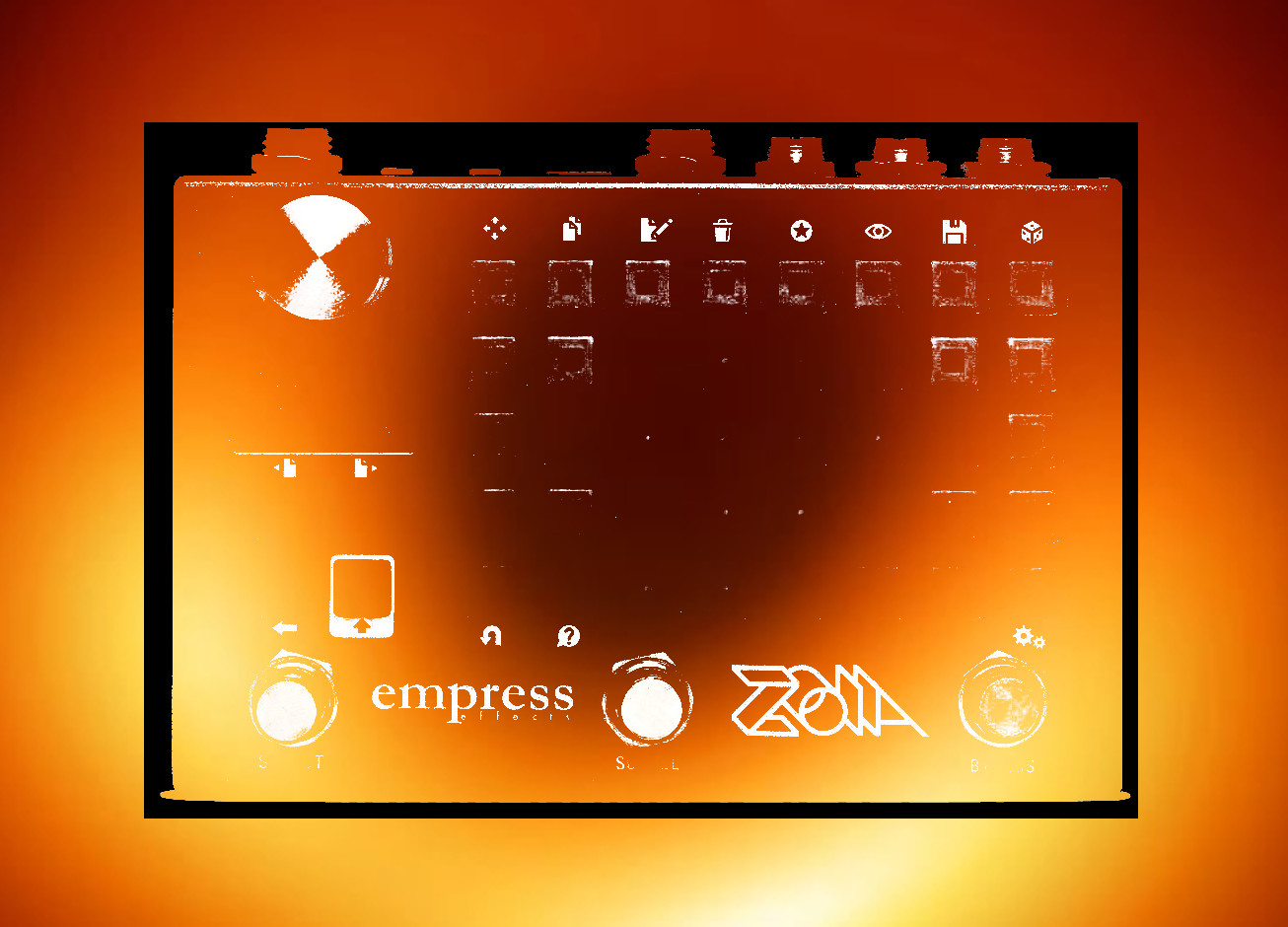This patch is meant to produce percussive and funky synth bass sounds, but the patch can produce a number of other synth sounds.
**This patch requires firmware 1.13 to function properly**
The general structure is a three-oscillator (sawtooth) monosynth, with an envelope controlled filter section.
I tried to keep the construction fairly straight forward, with the exception that instead of using an envelope follower-controlled VCA to control the amplitude of the oscillators, instead, I used an audio multiply (a ring mod, although the distinction between a VCA and a ring mod is a bit ambivalent). Here, the amplitude of the input signal essentially gates the oscillator. Because of the amplitudes required for an audio multiply to function properly, it produces some distortion, which I thought complimented the sound of the oscillators.
I also added a few quirks, like tap-tempo envelope lengths, the ability to introduce a very basic FM sound (oscillator 2 becomes the modulator to oscillator 1), different response curves for the envelope, and the option to switch between low-pass and band-pass filtering.
The signal path is mono, using the left audio input and output.
Controls:
Footswitches:
Left — envelope length; you can tap in an envelope length — this can also be set with the “Envelope length” control **
Middle — FM on/off; this can also be toggled with a UI button in the mixer section; when FM is selected, the UI button will turn from aqua to white
The FM option re-routes oscillator 2 from the output of the mixer section (muting it) to the FM input of oscillator 2. The oscillator level control will function as an FM index control.
Right — LP – BP switch; changes the filter from lowpass to bandpass; this can also be toggled with a UI button in the filter section; when the filter type is changed the UI button will change from lime (low-pass) to blue (band-pass)
Front page:
There are four major sections for patch control: the oscillator/mixer section, the filter section, the envelope section, and the dynamic controls.
The mixer section features a level control and on/off switch for each of the oscillators as well as a dry signal.
Each oscillator also features a “frequency” control: This is set relative to the pitch detected at the audio input. These can be set above or below this pitch.
Oscillators 2 & 3 also have a “fine tune” control. This allows you to tune the oscillators -/+ 50 cents, relative to the frequency they are set to. When all of the oscillators share the same frequency, detuning can allow for some very thick/chorused oscillator sounds.
There is also an FM switch, located in oscillator 1’s mixer section. (See entry on “Middle” stompswitch.)
There is also a portamento control, using a CV filter to create glides between notes.
The filter is pitch-tracked (and CV filtered), just as the oscillators are. This is intended to simplify the filter controls, by providing a very basic method of key-tracking the filter.
The filter section features a “Filter frequency” control as well. This is based on the same principle as the frequency control of the oscillator section: it sets the frequency of the filter relative to the frequency detected at the input. Unlike the oscillator frequency control, this only has a positive position.
There is a “Resonance” control; this control has been attenuated to provide the most usable resonance range (approximately from 1 to 42; above this, the resonance becomes very shrill and increases gain quite a lot).
The “LP – BP” switch controls whether the filter’s output is set to low-pass or band-pass. (See entry on “Right” stompswitch.)
The “envelope depth” control determines how much the filter frequency is affected by the envelope. The control is bipolar, with positive and negative amounts possible.
The envelope is an attack/decay envelope, controlled by an onset detector. It is set to retrigger at each transient the detector identifies.
There is an “Envelope shape” control: at 0, the envelope has a fast attack and slow decay, like a sawtooth; at 1, the envelope has a slow attack and a fast decay, like a ramp. **
There is an “Envelope length” control. The length of the envelope can be set either by this control or via tap tempo (left stompswitch). The envelope length control is attenuated to a total time of 6 seconds, but an envelope of any length (up to 60 seconds) can be tapped in.
The “Linear envelope” pushbutton will switch the output of the envelope from exponential to linear. Expenontial envelopes have a “snappier,” more percussive sound, while linear envelopes have a smoother rise and fall.
The “Loop envelope” pushbutton allows the envelope to be looped, functioning as an LFO. The LFO is “key-synced,” meaning it will resume each time a new transient is detected by the onset detector.
There is also a pixel to show the shape and time of the envelope.
The dynamics section is fairly simple.
There is a gate threshold control. The gate really only exists to cut down on the noise from the patch when not in use and to mitigate the fact that sometimes the onset detector interprets the release of a string as an attack. The gate is fairly aggressive; if you wanted to change its behavior, it is located on the filter page.
The sensitivity control affects the sensitivity of the onset detector. 0 is less sensitive, which may be useful if you want to use the envelope as an accent. 1 is more sensitive, and can lead to inadvertent triggerings of the envelope. I generally find that somewhere between .3000 and .5500 is my personal sweet spot, but it depends a lot on your playing dynamics and input signal.
** The tap tempo envelope and envelope shape controls are modified versions of the patching techniques explored in this set of patches and video: https://patchstorage.com/firmware-1-13-explorations/


